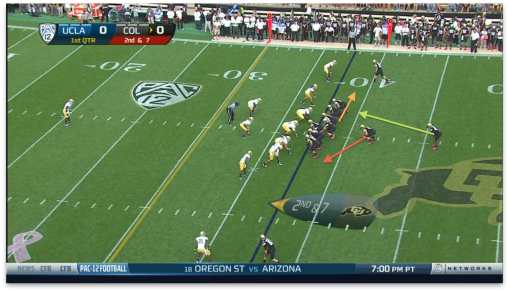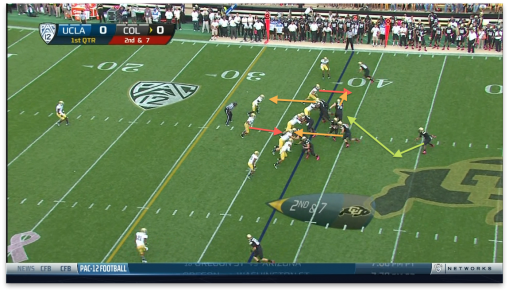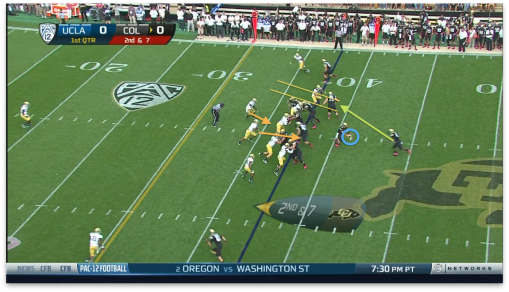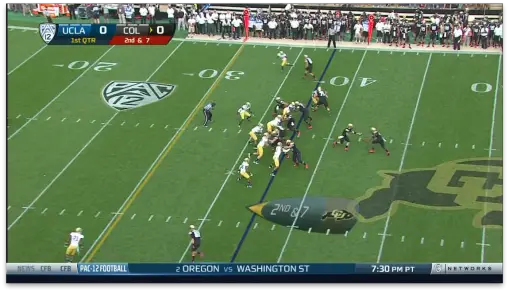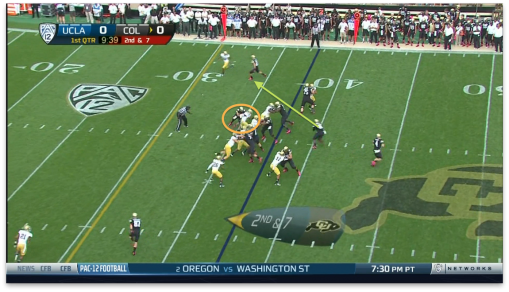As luck has it, Oregon faced all of its spread opponents in the early part of the season, and will face all of its pro-style opponents in the second half of the season. Colorado is a perfect primer for the rest of Oregon’s schedule, and will allow the Ducks some time to adjust to a different style of play.
That is unless Colorado, and the teams that follow the Buffs, aren’t very different from Oregon.
Supposedly, there’s a very big difference between Oregon’s offense and Colorado’s…all statistics notwithstanding, of course. First, there’s the quarterback, who lines up under the center most of the time in Colorado’s offense, while Oregon’s quarterback almost never lines up under center. Then there’s the… hmm… well, Colorado likes running the power play. So does Oregon. Colorado likes using outside zone, inside zone, play action, and dives. So does Oregon. The same could be said for any of the remaining teams on Oregon’s schedule.
Aesthetics, and more than a few points per game, are the only thing separating Colorado’s offense and Oregon’s.
That is, aside from one mysterious play: the counter play.
For some unknown reason, Oregon hasn’t used the counter concept in more than a half-decade. For that reason alone, there should be considerable panic regarding the Colorado offense pummeling an unprepared Duck defense with this bizarre counter play.
In all seriousness, Colorado does have a big running back and a physical tight end, and their abilities were showcased on this particular counter ran against UCLA.
The counter play is essentially play-action on the ground, as it fools the defense into thinking a play is going one direction, and then going another. Linebackers usually read different players on the offense to find “keys” to the direction of a play. For instance, the linebackers may read the fullback to see where the play is headed. On this particular counter play, the fullback counters to the left, while the play goes to the right. In the pictures below, see how the defense anticipates a play going to the offense’s left, when in reality it is headed to the right.
As shown below, the running back takes his “counter-step” to the left when the ball is snapped. The defense reacts to the counter step, and shifts towards the wide side of the field. The fullback proceeds to his left, further confirming the defense’s prediction. While the defense is watching the backfield, the right guard pulls to the outside to kick out the defender (topmost red arrow). That block will prove to be one of the “spring” blocks on this run.
Step forward another frame, and the counter action becomes even more complex. The quarterback opens up to his left, and has the ball in his right hand, indicating a run to the left. The defense reacts accordingly, and it appears as if the Bruins are in position to make the play.
Step forward one frame, and the Colorado quarterback has switched hands, and the running back plants and head the other direction!
At this point, UCLA’s defense is way out of position. The Bruins were quite literally tricked into going one direction, before having to go another. The kick-out block opens the lane, and the tight end (orange circle) finishes his double-team with a great second level block. The running back heads for the big hole to the right, and cuts upfield for a good gain.
I expect to see plays like this throughout the game, because Colorado should run their offense as usual, even if they are down by 30+ points. Counter plays are good for developing offenses, because they make blocking defenders a lot easier, simply because the defender will lose time in pursuing the play, and will not have a suitable angle to beat a block.
Hopefully the Buffs will run this play, and remind Chip of the deadly concept he once used.
Related Articles:
Chip Kelly Update: Everything's Good Again ...
Chip Kelly Update: Wailing and Gnashing of Teeth
Shock and Awe -- The Oregon Ducks' Football Hangover Effect
Despite Lopsided Score, Georgia State "Never Stopped Believing"
Hope Springs Eternal for Ducks
Incompetent Pac-12 Officials: How Do You Miss ALL of THIS?
Josh is a College Football enthusiast from sunny Southern California. He has written for several self-operated prep sports blogs, as well as multiple SB Nation sites. In High School, Josh played football for four years, and helped create and operate the team’s no-huddle system. Most of Josh’s football knowledge branches from watching College Football his entire life, and is backed up by his first hand experience in both option and spread offenses. Above all, though, he is a proud student at the University of Oregon.
@joshschlichter

